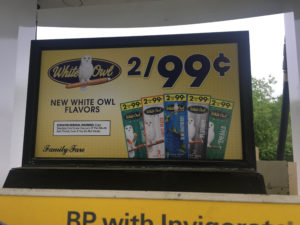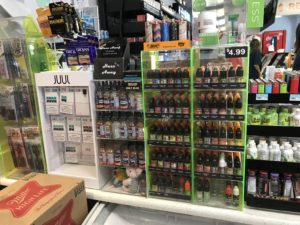Welcome to CounterTobacco.org’s “News and Research Roundup!” Each month we post a summary of the latest research, reports, and news stories on counteracting tobacco product sales and marketing at the point of sale (POS). Keeping up with what’s happening in the POS movement all across the country can help you choose policies and strategies that work best for your community. New research can help provide support for your work and evidence for the importance of the “War in the Store.” Have a story you don’t want us to miss? E-mail it to us!
New Research
Point of Sale
- Point-of-sale marketing of little cigars and cigarillos on and near California Tribal lands, Tobacco Control

- American Indians have the highest rate of cigarette smoking of any racial or ethnic group in the US. As such, a study was conducted between 2015 and 2017 to audit 53 retailers on Tribal lands and 43 retailers within a 1 mile radius of Tribal lands in California to assess the landscape of little cigars and cigarillos. They found that, overall, 85% of stores sold little cigars and cigarillos, 76% sold flavored versions, and over half sold these tobacco products for less than $1. In 47% of retailers, price promotions for these products were displayed inside the store. Stores that were in the immediate surrounding area, but not directly on Tribal Lands, sold significantly more flavored and total little cigars and cigarillos, displayed significantly more of these items for less than $1, and were more likely to advertise price promotions on these products. To counteract the wide rates of use in this population, policymakers should consider implementing regulations to these otherwise widely available and extremely cheap tobacco products. Learn more about increasing prices on these tobacco products through non-tax approaches.
Tobacco Retailer Density
- Tobacco retail density and initiation of alternative tobacco product use among teens, Journal of Adolescent Health
- Researchers assessed data from over 700 adolescents, aged 13-19 years old, living in 191 different neighborhoods in California to determine the association between tobacco retailer density and the initiation of alternative tobacco products (ATP) after one year. Data showed that, at baseline, one-third of participating teenagers ever used an ATP and within one year 21.5% of baseline nonusers initiated use of an ATP; as well, the average distance between each participant’s place of residence and the closest tobacco retailer was just over half a mile. Controlling for individual and school factors, researchers found that those living in neighborhoods with a greater density of tobacco retailers had 1.22 times the odds of ATP initiation than those living in neighborhoods with a lower density of tobacco retailers. Learn more about retailer density.
Mint, Menthol and Other Flavors
- The effect of flavoured and non-flavoured tobacco on subjective experience, topography, and toxicant exposure among waterpipe smokers, Tobacco Control
- This study with 144 participants assessed differences between waterpipe smoking sessions with flavored and non-flavored tobacco. Participants who engaged in the flavored smoking session reported greater satisfaction and enjoyment and spent a longer amount of time smoking; contrastingly, those who engaged in the non-flavored smoking session took larger puffs and exhaled more carbon monoxide than those in the flavored smoking session. As well, participants who smoked non-flavored tobacco, as opposed to their preferred flavor, reported higher perceptions of waterpipe harm. These findings suggest that regulating flavors of waterpipe tobacco may reduce waterpipe use since subjective experience was enhanced in those who smoked flavored waterpipe tobacco. Learn more about hookah at the point of sale.
E-Cigarettes
- Perceived comparative harm of cigarettes and electronic nicotine delivery systems, JAMA Network Open

- Data from the Tobacco Products and Risk Perceptions Surveys found that between 2017 and 2018, the percentage of US adults who perceived electronic nicotine delivery systems (ENDS) to be less harmful than cigarettes decreased by 3.5%; as well, the percentage of US adults who found ENDS to be ‘more’ harmful increased by 2% and ‘much more harmful’ by 1.8%, with an increasing proportion of these individuals being current and former smokers. The percentage of adults who perceived ENDS to be equally as harmful as cigarettes increased by 6.6% and the percentage of adults uncertain of the comparative harm between cigarettes and ENDS decreased by 6%. While this data was collected prior to the recent vaping-related illnesses and deaths, the findings of perceived harm are important to assessing trends of use. It is hypothesized that these changes in harm perception are associated with the increased media attention and political response to ENDS use during this time period. Learn more about e-cigarettes.
- News story: Study finds increase in US adults who perceive e-cigarettes more harmful than cigarettes, EurekAlert!
International
- Can public health policies on alcohol and tobacco reduce a cancer epidemic? Australia’s experience, BMC Medicine
- This study assessed the association between tobacco control policies, tobacco use, and tobacco-related cancer mortality in Australia from the 1950s to 2013. Their analysis found that tobacco policies [banning cigarette ads on television and radio, banning tobacco ads in print media, initiating smoke-free regulations in workplaces and health warning labels on packages] were correlated with reductions in tobacco smoking and tobacco-related cancer deaths. This analysis evidences the impact tobacco control regulations can have on tobacco use and tobacco-related mortality. Learn more about policy solutions.
- News story: Research: Alcohol and tobacco policies can reduce cancer deaths, EurekAlert!
Other
- Awareness and interest in IQOS heated tobacco products among youth in Canada, England, and the USA, Tobacco Control
- Heated tobacco products such as IQOS have hit the markets here in the states and internationally. This study used data from the International Tobacco Control Youth Tobacco and E-cigarette Survey in 2017 to assess youth, aged 16-19, awareness, interest in trying and susceptibility to trying the IQOS. 9.1% of American youth respondents reported awareness of the IQOS product and 41% reported interest in trying the product. As well, susceptibility for trying IQOS, which was measured by a question asking whether the respondent would try the product if offered by his/her best friend, was higher than susceptibility for trying cigarettes but lower than susceptibility for trying e-cigarettes. Those who were male, current tobacco users, and current e-cigarette users were more likely to show interest and susceptibility to trying IQOS. Learn more about IQOS.
- Exposure to tobacco marketing in bars predicts subsequent use of multiple tobacco products among non-tobacco-using college students, Tobacco Control
- This study of approximately 1,500 students aged 18-29 assessed the association between exposure to tobacco marketing in clubs and bars and the number of alternative tobacco products used six months later. Findings evidenced that a greater exposure to free tobacco samples and tobacco industry representatives at these locations was associated with a greater number of alternative tobacco products used six months later, but only for those who were non-tobacco users at baseline. While the tobacco industry generally claims that their marketing and advertising tactics target current users, this study suggests that tobacco marketing in bars and clubs actually influences use among non-tobacco users, not current tobacco users. Learn more about restricting tobacco advertising.
- Tobacco product use and associated factors among middle and high school students – United States, 2019, MMWR
- This report provides updated statistics on youth and adolescent use of tobacco products in the US. In 2019, 31.2% of high school students and 12.5% of middle school students used a tobacco product in the past 30 days. Similar to previous years, e-cigarette use was most common among this age group and reasons for use and initiation included flavor options, exposure to tobacco product marketing, curiosity and susceptibility, and misperceptions of harms associated with tobacco use. Learn more about youth use.

- This report provides updated statistics on youth and adolescent use of tobacco products in the US. In 2019, 31.2% of high school students and 12.5% of middle school students used a tobacco product in the past 30 days. Similar to previous years, e-cigarette use was most common among this age group and reasons for use and initiation included flavor options, exposure to tobacco product marketing, curiosity and susceptibility, and misperceptions of harms associated with tobacco use. Learn more about youth use.
New Reports
- Colorful and close to candy: Surveying how the tobacco industry markets flavored products in stores, Truth Initiative
- This report highlights findings from a pilot study between Truth Initiative and Counter Tools. Using store assessments, the pilot study evaluated point of sale industry marketing strategies and its impact on youth tobacco use.
Industry News
- FDA to review Vuse, Winston-Salem Journal
- Tobacco companies introduce ‘tobacco-free’ nicotine pouches, Tobacco Control
- E-cigarette regulations survive industry’s legal challenge, Bloomberg
- Appeals court upholds FDA’s authority to regulate electronic cigarette, Convenience Store News
- FDA permits sale of two new reduced nicotine cigarettes through premarket tobacco product application pathway, FDA
POS Policy in the Media 
E-Cigarettes
- After deaths, ban on flavored vapes to be passed by New York City, The New York Times
- S. Senators send letter to the Trump Administration criticizing latest walk back from strong tobacco regulation, Sierra Sun Times
- Oversight Subcommittee to question FDA tobacco director over status of Trump’s vaping ban, The Hill
- [NY] Nassau lawmakers pass ban on most flavored e-cigarettes, liquid nicotine, Newsday
- Philadelphia to restrict sales of flavored e-cigarettes, The Philadelphia Inquirer
- Jersey City bans the sale of flavored e-cigarettes, Patch
- [Palmdale, CA] City bans sale of vaping products, Antelope Valley Press
- [CA] Palo Alto to ban sales of vaping products, Palo Alto Online
- [MA] Vape sales resume, with warning from State Health Commissioner, WGBH
- New York state renews ban on flavored vaping liquids, CNN
- [CA] Ventura County bans sale of flavored vaping products, CBS Los Angeles
- Montana Health Department to enforce flavored vaping ban, US News & World Report
- [CA] Oxnard sets regulations on pot dispensaries, bans flavored tobacco, VC Star
- [NY] Vape shop moratorium extended in Bethlehem, com
- [MN] Vape ban on: Ravalli County judge’s decision launches flavored products ban, Ravalli Republic
- [Philadelphia, PA] Mayor Kenney signs 3 bills to restrict sale of vaping and tobacco product, NBC Philadelphia
Tobacco 21
- [CO] Garfield County raises tobacco purchasing age, Post Independent
- Pennsylvania increases cigarettes, tobacco purchasing age from 18 to 21, CBS Philly
- 21 to buy tobacco products? It could happen under healthcare bill, Winston-Salem Journal
- [NH] Durham’s new ordinance places age restriction on tobacco sales, The New Hampshire
- Indiana governor announces plan to raise smoking, vaping age to 21, WLWT5
- Bill to raise minimum age to buy tobacco products in Kentucky to 21 pre-filed, Local12
- Congress poised to raise smoking age to 21, Forbes
- Plan to ban tobacco sales to anyone under 21 will hit the military too, Military Times
- Senate passes bill banning tobacco sales to anyone under 21, The Hill
Menthol and Other Flavored Tobacco Products
- Boston restricts mint, menthol tobacco sales to adult-only tobacco retailers, Mass Live

- Baker signs groundbreaking bill banning flavored tobacco, vape products, NBC Boston
- Key city committee backs ban on flavored tobacco, menthol in Los Angeles, ABC7
- [Morgan Hill, CA] Council bans e-cig, flavored tobacco sales, The Morgan Hill Times
- [Santa Barbara, CA] Supervisors approve flavored tobacco ban, Edhat
- [CA] Alameda County Supes approve flavor ban including menthol cigarettes, CBS SF Bay Area
Tobacco Retailer Licensing
- [CA] Benicia Council passes smoking ordinance, Benicia Herald
- [CA] Fremont’s tobacco retail license program now in effect, Patch
Other
- [ME] South Portland approves buffer zone for stores that sell tobacco, WMTV
- Massachusetts Health Board approves new restrictions on the sale of tobacco products, Convenience Store News
- [MA] Concord considers banning sale of tobacco products at convenience stores, NBC Boston
- [CO] Pitkin County commissioners nix idea of punitive measures for minors caught smoking, Aspen Daily News
Find more stories in last month’s News and Research Roundup.
Know of a story that we missed? Email us, and we’ll be sure to include it in next month’s roundup!


